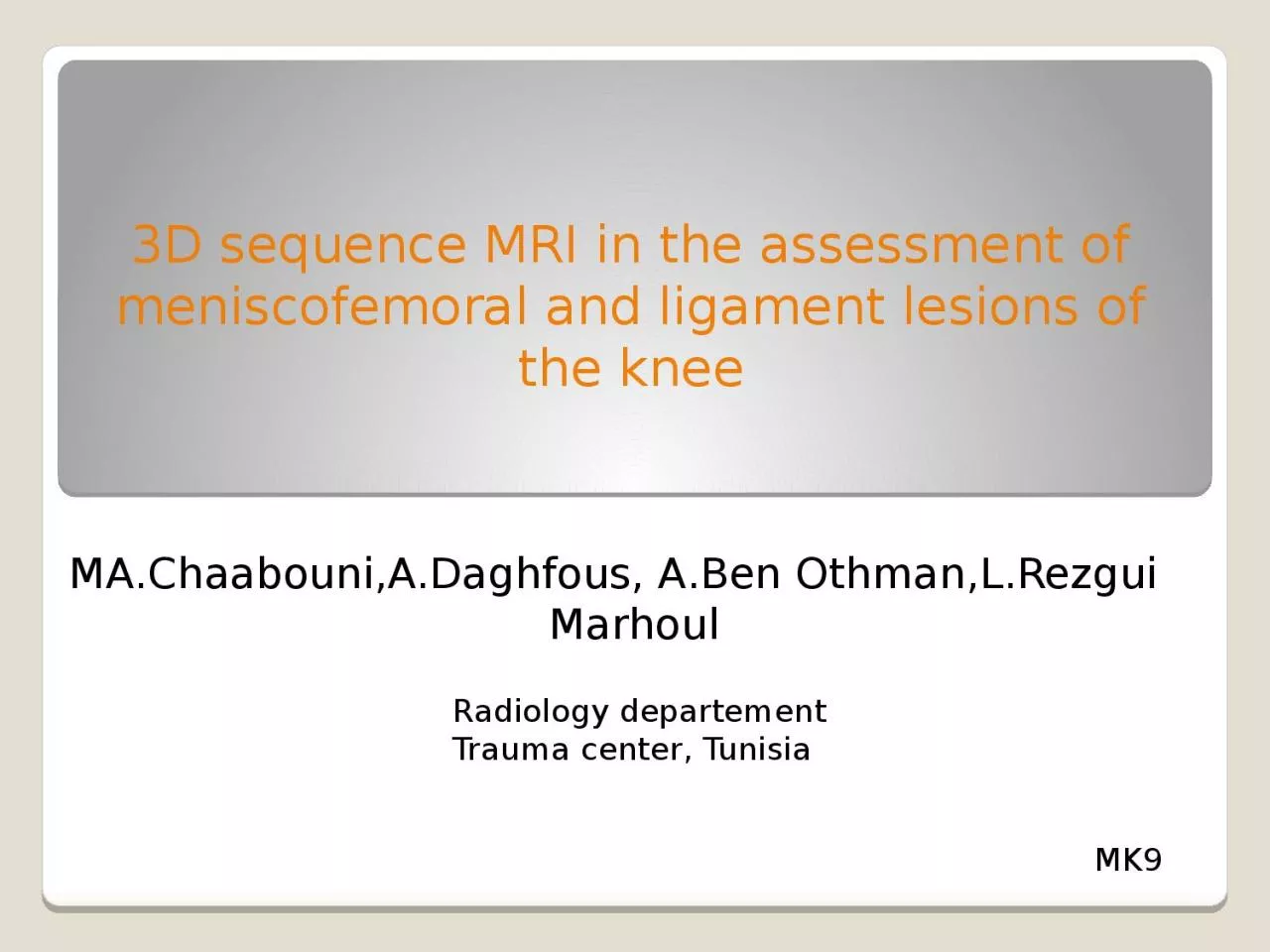

assessment of meniscofemoral and ligament lesions of the knee MAChaabouniADaghfous ABen OthmanLRezgui Marhoul Radiology departement Trauma center Tunisia MK9 ID: 931079
Download Presentation The PPT/PDF document "3D sequence MRI in the" is the property of its rightful owner. Permission is granted to download and print the materials on this web site for personal, non-commercial use only, and to display it on your personal computer provided you do not modify the materials and that you retain all copyright notices contained in the materials. By downloading content from our website, you accept the terms of this agreement.
Slide1
3D sequence MRI in the assessment of meniscofemoral and ligament lesions of the knee
MA.Chaabouni,A.Daghfous, A.Ben Othman,L.Rezgui Marhoul
Radiology departementTrauma center, Tunisia
MK9
Slide2INTRODUCTIONMagnetic resonance imaging
(MRI) is sensitive and specific in the diagnosis of internal derangements of the knee . The fast spin-echo (SE)
intermediate-weighted
sequence
widely
used to evaluate ligaments, tendons, and
fibrocartilage
owing to its favorable contrast
and signal-to-noise ratio .
Multiplanar
imaging
or 3D
sequence
,
which
usually
takes longer, is often used for knee MR imaging because of the necessary assessment
of
complex
musculoskeletal
structures.
Volumetric
imaging
also offers an opportunity to reduce the
imaging time by allowing
multiplanar
reformations.
Slide3Our objective is to determine whether 3D sequences can
improve the diagnostic performance of a routine MR protocol for detecting
meniscal and ligament lesion
of the
knee
.
Slide4MATERIALS AND METHODS Retrospective study
: 56 patients who had knee MRI 1,5 Tesla for
suspected meniscal and/or ligament
lesions
.
Two
years
:
done
between
January2010 and
December
2011.
Our
protocol
uncludes
conventional
sequences (coronal, sagittal and axial Proton
Density
Fast
-Spin Echo and sagittal T 1) and
systematic
sequence
3D
thin
sections.
We
propose
it
as the basis for the
analysis
of
meniscal
and
ligament
lesions
.
Slide5RESULTS All meniscal and ligament tears was shown equally well with 2D and 3D sequences.
The 3D sequence allows a more
precise analysis of
these
lesions
.
Of the 56 cases
studied
by MR
imaging
,14
were
normal,24
had
meniscal
tears
,15
had
ACL
tears
and 3
had
PCL
tears
.
Nine
of the
menisci
were
longitudinal
tears
, 6 vertical
tears
, 4 radial
tears
, 3
complex
tears
and 2
seal
cove
tears
.
Slide6Fig.1: A 34 -year-old female
patient with PCL tear ( ) of the right knee
Sagittal images
obtained
with
2D FSE (a) and 3D sequences (b) at 1,5T
a
b
Slide7Fig.2:A 38-year-old
male patient with a complex tear of the medial meniscus
posterior
horn
. ( )
Sagittal images
obtained
with
2D (a) and 3D sequences
(b) at 1,5 T.
Axial images
obtained
with
2D (c) and 3D FSE sequences (d) at 1,5T.
a
b
c
d
Slide8a
b
c
d
Fig.3:A 45-
year
-
old
male patient
with a longitudinal tear of the
medial
meniscus
posterior
horn
.
Sagittal and axial images
obtained
with
2D (
a,c
) and 3D FSE sequences
(
b,d
)at 1,5T. The tear
is not
visualised on the axial 2D FSE sequence
but
well
visualised
on 3D
Slide9Fig.4: A 21 -year-old female patient
with a seal cove tear of the medial meniscus
posterior horn
( )
Coronal and sagittal images
obtained
with
2D (
a,c
) and 3D FSE sequences
(
b,d
) at 1,5T.
a
b
c
d
Slide10Fig.5: A 27-year-old male patient with
ACL tear of the left knee
.Sagittal images
obtained
with
2D (a) and 3D FSE sequences (b) at 1,5T.
a
b
Slide11DISCUSSIONThe described 3D isotropic
fast SE intermediate weighted MR
sequence enables
thin-section data acquisition without intersection
gaps and
multiplanar
image reformation in standard and
nonstandard
planes that may be helpful for the
detection and analysis of complex structures.
The 3D Fourier transform acquisition is
conceptually
attractive for
musculoskeletal
MR imaging because it facilitates image reformation in
complex oblique planes
after image acquisition.
.
Slide12Duc et al (28) reported 3D isovoxel true fast Imaging with steady-state precession to have sensitivities, specificities, and accuracies of 80%, 95%, and 90%,respectively, for the diagnosis of ACL tears; 100%, 82% and 90%, respectively, for the diagnosis of MM tears; and 83%, 83%, and 83%, respectively for the diagnosis of LM tears.
While image quality consistently scored lower with the 3D compared with the 2D FSE sequences, the diagnostic performance was similar, though radiologists felt more confident diagnosing abnormalities with the 2D sequences.
Slide13In our serie, both the 2D and the 3D sequences provided subjectively high-quality images with comparable anatomic detail
. All meniscal and ligament tears was shown equally well with both techniques.
John and all showed that for meniscal tears, the superior sensitivity of the 3D sequence became evident .
Slide14The thinner slice thickness and resultant dimunition in volume-averaging may have been responsible for this observation, especially in the case of small tears. However, the Heightened sensitivity to intrameniscal signal afforded by the 3D technique also contributes to its decreased specificity relative to SE imaging.
Slide15Because a greater volume of signal could be identified within the meniscus, it often became more difficult to determine whether the abnormality communicated with the meniscal surface, thus differentiating internal degeneration
from actual tear
. Long scan times have limited the clinical utility of 3D spin- echo imaging implementations.
Slide16CONCLUSION Although the fact that 3D isotropic fast SE intermediate-weighted MR imaging of the knee is a real plus for the analysis of cruciate ligament and
meniscal tears, it yields accuracy that is not significantly different from the accuracy of 2D fast SE MR imaging .